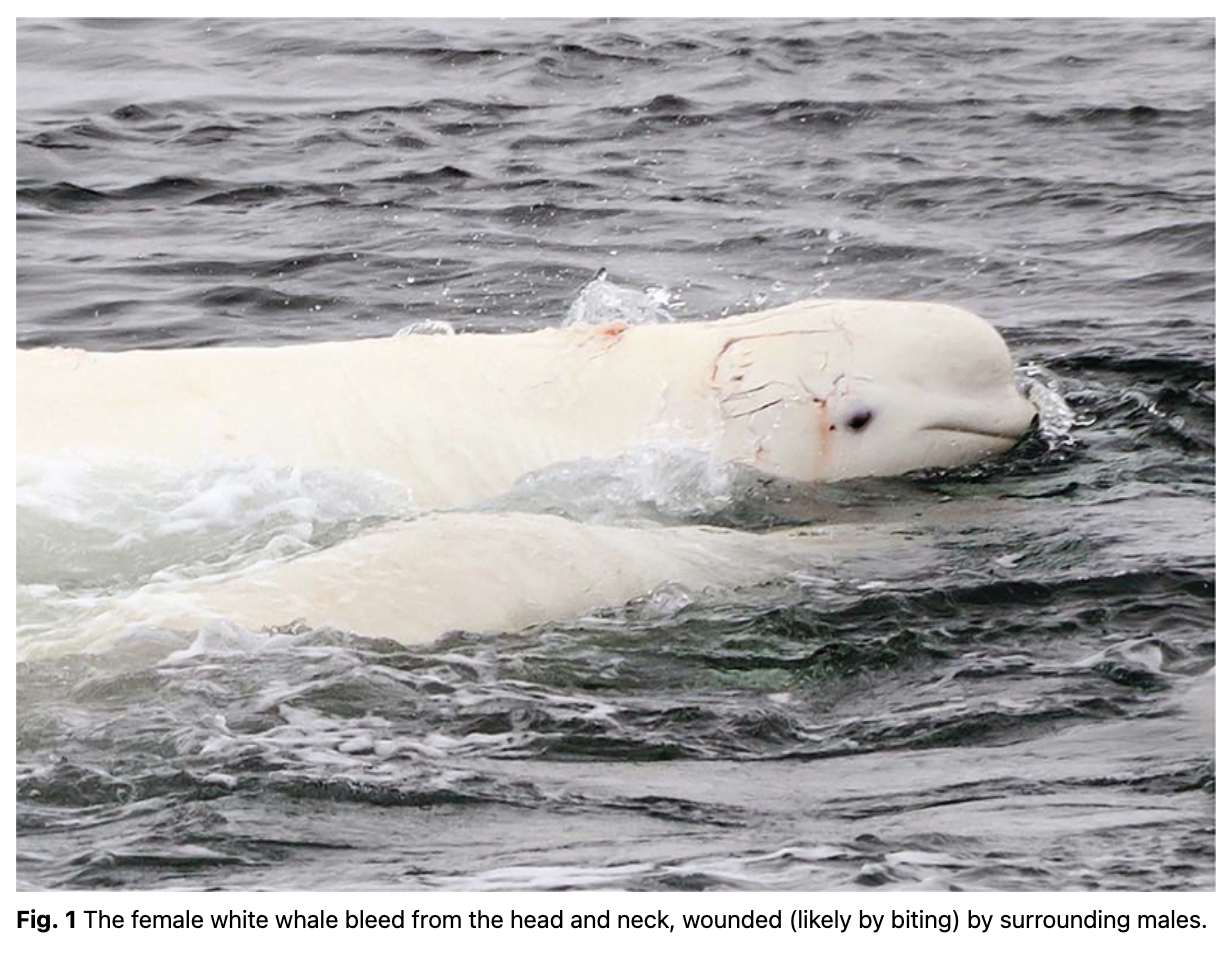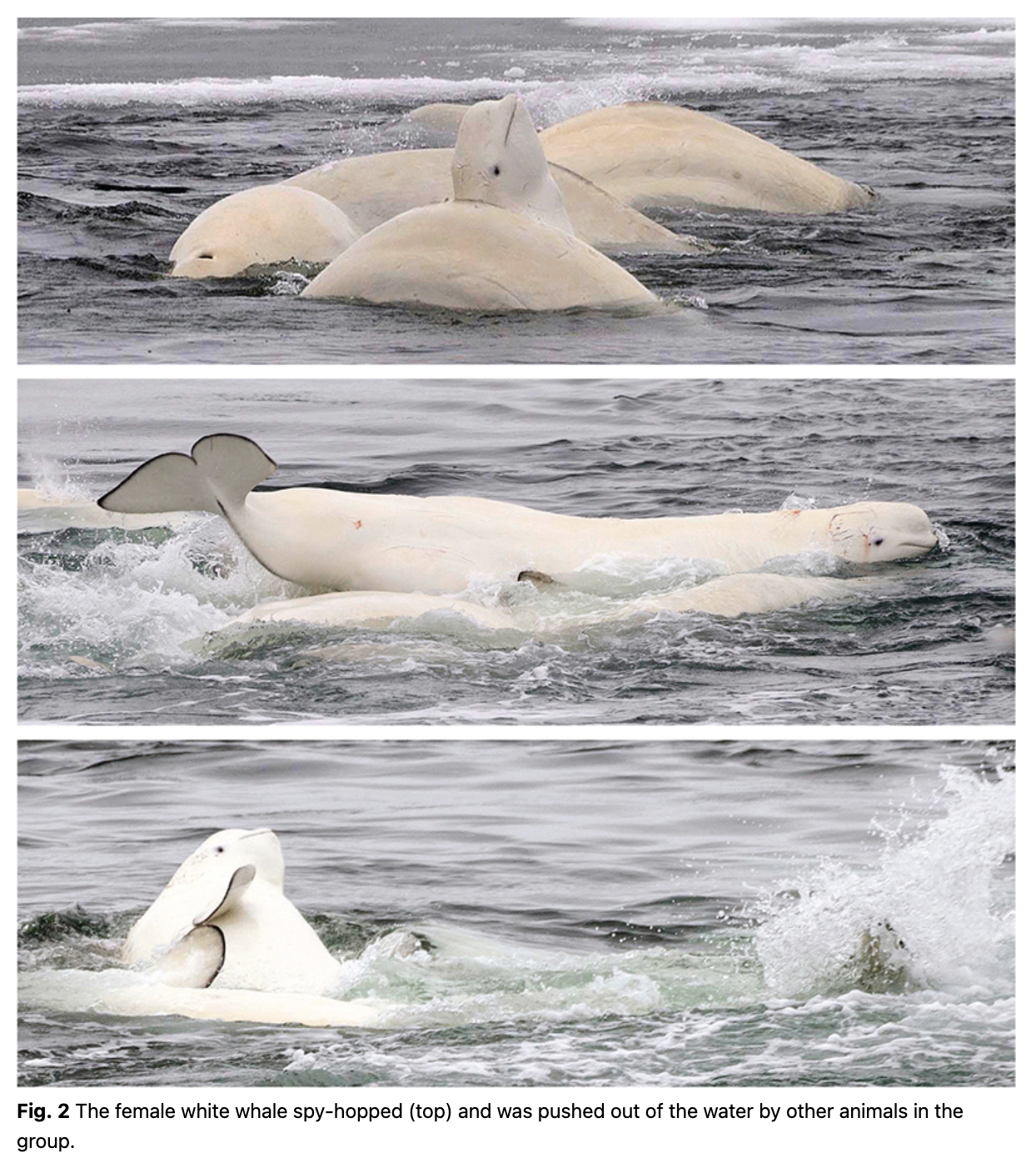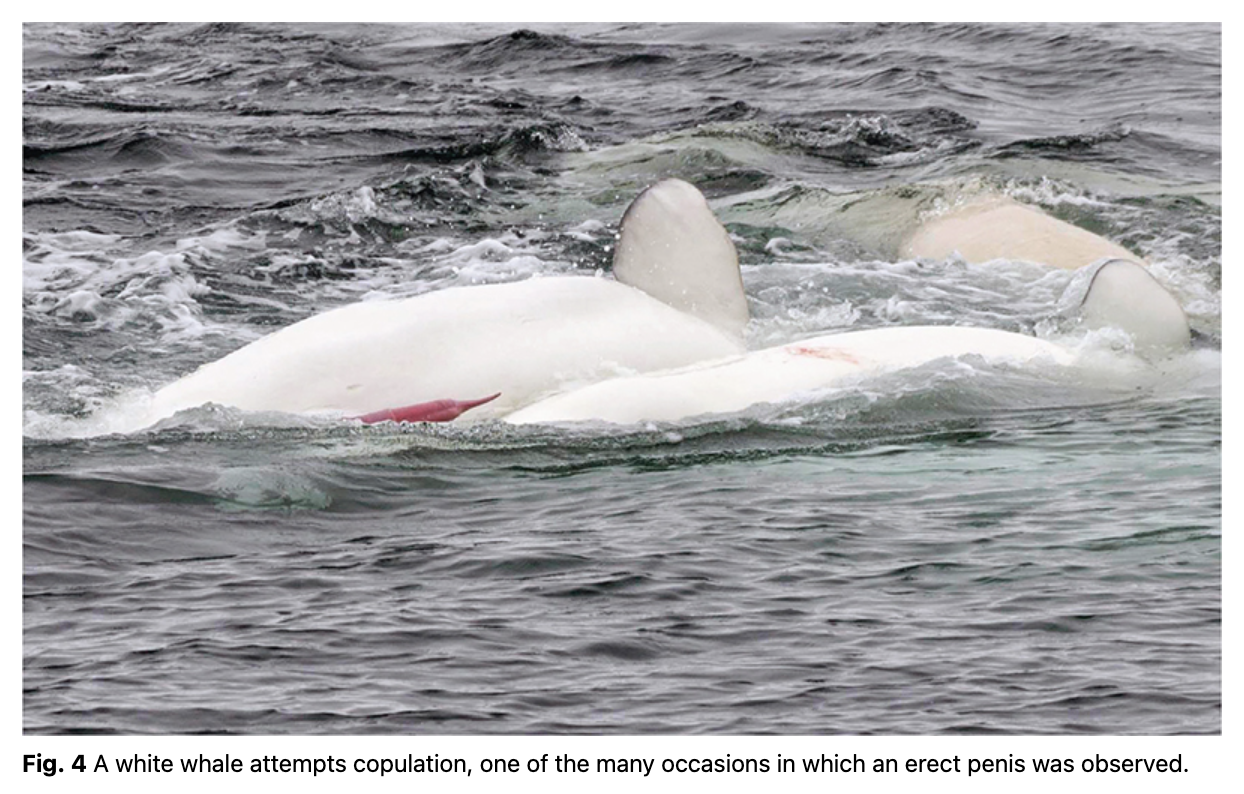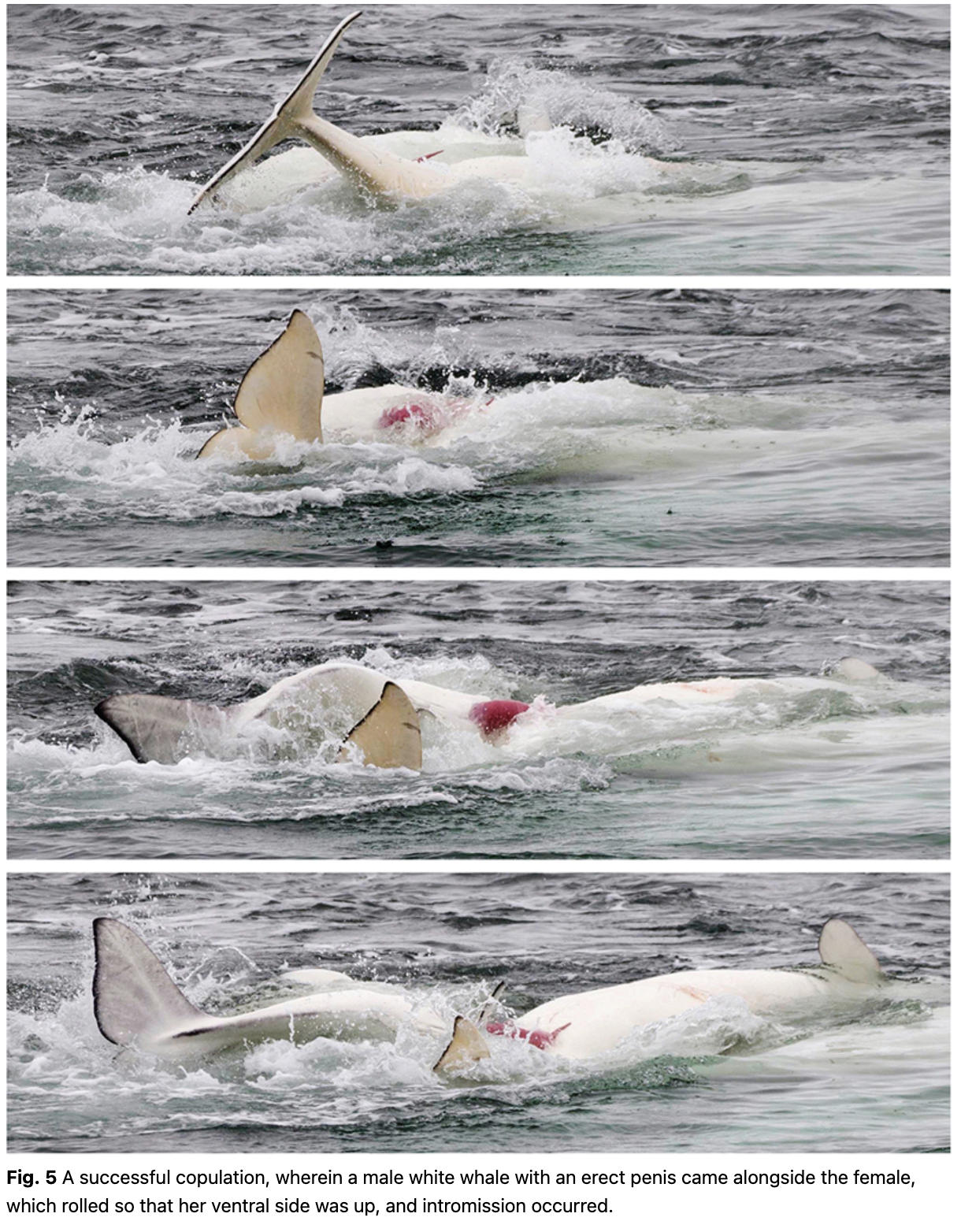An observation of white whale (Delphinapterus leucas) mating behaviour in the wild


Опубликована Янв. 1, 2023
Последнее обновление статьи Июль 25, 2023
Abstract
Herein we describe mating behaviour observed in a group of 20 white whales in Svalbard, Norway. A single female was the centre of attention during the 45-minute encounter, which was observed, photographed and videotaped at an ice edge in Storfjorden in June 2022. Several males surrounded the female and vigorously herded her from all sides. The female spy-hopped regularly, and sometimes her whole body was pushed out of the water by the other animals. High tail-lifts and tail-slapping were frequently performed by males, and erect penises were observed many times. Trumpet calls were also heard. At one point, three males with erect penises pressed themselves against the female simultaneously.
Ключевые слова
Reproductive behaviou, forced copulation, Svalbard Norway, Aggressive group mating, beluga
Introduction
White whales (Delphinapterus leucas) have a circumpolar Arctic and Subarctic distribution (O’Corry-Crowe 2018). Twenty-one stocks are currently recognized (Hobbs et al. 2019); one of these resides around Svalbard, Norway. This is one of the smallest stocks, which was recently estimated to number 549 individuals (95% confidence interval: 436−723; Vacquie-Garcia et al. 2020), although white whales are the most commonly observed cetacean in Svalbard (Storrie et al. 2018; Bengtsson et al. 2022). Reasons for this seeming discrepancy include the fact that white whales are easy to spot and spend most of their time in the summers in coastal waters off the west coast of Svalbard, where their distribution overlaps with people (Vacquie-Garcia et al. 2018). White whales in Svalbard have been studied since the mid-1990s (see Lydersen & Kovacs 2021 for review), but very little is known about their reproductive biology locally. This is also true for white whales generally throughout their range in the wild.
Lomac-Macnair et al. (2015) describe socio-sexual behaviour and probable mating behaviour for Cook Inlet, Alaska, white whales. However, a variety of socio-sexual behaviours take place among cetaceans for social purposes, such as developing and maintaining relationships between individuals that are not actually mating. Such behaviour can occur across and within age and sex groups. Mating behaviour in most mammals, on the other hand, is related to conception and involves sexually mature individuals of the two sexes (Hill et al. 2015). The Cook Inlet white whale interactions described by Lomac-Macnair et al. (2015) were observed from an aircraft on two different days, and in one case, they were photo-documented. The encounter that was photographed involved a group of nine animals. Six of these whales formed three pairs, each of which displayed socio-sexual behaviours. These included ventrum-to-ventrum contact, ventral presentations, pelvic thrusting, nodding and rubbing. The second encounter involved four adult white whales engaged in socio-sexual behaviours. Two of these white whales chased another individual and appeared to manoeuvre for proximity to this third central animal.
The various socio-sexual behaviours observed in Cook Inlet resembled those previously described by Hill et al. (2015) for captive white whales. These authors developed a catalogue of socio-sexual behaviours in white whales based on 800 hours of observations over a seven-year period, involving 11 animals of different ages, including both males and females. When this catalogue was applied to white whales at two other facilities, the behavioural similarities suggested that they were typical behaviours for the species. Several other studies of sexual or socio-sexual behaviour among captive white whales have been reported in the literature (Recchia 1994; Glabicky et al. 2010; Ham et al. 2022), but only Lomac-Macnair et al. (2015) have reported socio-sexual behaviour of white whales in the wild.
Observation in Svalbard
During a cruise in Svalbard waters with the ship National Geographic Endurance (National Geographic n.d.), a pod of white whales was observed in dense pack ice at a fast-ice edge in northern Storfjorden (78°24.9N, 019°11.9E), on 4 June 2022. Initially, it was a large group containing many small grey juveniles as well as adults. This large pod split and a group of 20 large animals (one of them grey and the rest white) commenced very boisterous behaviour. This group of whales clustered tightly and performed highly synchronized behaviours; most members of the group surfaced and dove simultaneously. It became clear after some time that the centre of attention was a single white female that was clearly distinguishable, in part because she was smaller than most of the other animals and was bleeding from wounds in several places, mainly on the head (Fig. 1).

All body parts of this female whale were observed at various times. She spy-hopped frequently, and sometimes her whole body was pressed out of the water by animals below her (Fig. 2). High tail-lifts and tail-slapping were frequently performed by males in the group (Fig. 3), and erect penises were observed many times (Fig. 4). The males formed a tight cluster around the female and herded her toward the ice edge. The group remained within 15 m of the ice edge most of the time, sometimes diving beneath the ice. It appeared as though the males prevented the female from diving deeply or swimming away, herding her from all sides. The female’s bleeding wounds seemed to be inflicted by bites from the other whales. In addition to bleeding from the head, she also bled from other body parts including the vaginal slit (see Supplementary Video). At one point, three males with erect penises pressed themselves against the female simultaneously. At least one successful mating attempt was photographed at the surface. A male with an erect penis came alongside the female, who gradually rolled over such that she had her ventral side up, and intromission occurred (Fig. 5). Given the number of males involved in the group, the 45-minute duration of the event and the extremely dynamic movements by the males during the interactions, it is likely that there were multiple mating events that involved more than one male.




The white whales did not react to the ship, which approached to about 120 m. The behaviour of the group persisted, and the whales approached the ship to approximately 100 m. When they were close to the ship, observers heard several distinct, loud trumpeting sounds during exhalations from one or more individuals (Supplementary Video). A few minutes later, the group dissolved, and the whales swam away along the ice edge. The whole event within the group of 20 lasted approximately 45 minutes.
Discussion
This is likely the first photo-documentation of mating in free-living white whales, at least in the scientific literature. In their account of an observation of white whale socio-sexual behaviour, Lomac-Macnair et al. (2015) could not determine the sex of the animals or confirm if mating occurred. Their observations were of animals of similar size. Because Cook Inlet white whales display the sexual size dimorphism typical of most white whale stocks, with males being larger than females (Vos et al. 2020), it seems most likely that the socio-sexual behaviour Lomac-Macnair et al. (2015) described took place between animals of the same sex.
Given the lack of direct observations, the timing and location of mating is not known for white whales in the wild. On the basis of the gestation period and timing of calving in the eastern Canadian Arctic, Brody (1989) suggested that white whales likely mate in spring in offshore areas or in polynyas. In a review based on traditional ecological knowledge in Chukotka, Russia, Mymrin et al. (1999) said that mating takes place in the autumn, and that the male white whales whistle under water and the females respond to the whistles, coming to mate with the males.
In captivity, copulatory behaviour (based on the observation of pelvic thrusting) was studied on a seasonal basis by Glabicky et al. (2010). A pelvic thrust was defined as any instance in which one whale approached another, rolled ventrally toward the other animal, and made contact with the other whale in its genital region, regardless of whether an erection was seen or not. Male-on-male pelvic thrusting varied across the months, while male-on-female pelvic thrusting peaked in March, suggesting that this was the period of the year when copulations occur. Of the 910 thrusting events observed by Glabicky et al. (2010) among adults, 59.7% were male-on-male, while 40.3% were confirmed to be male-on-female. During bisexual encounters, an erection was seen during 59.2% of the observations, whilst intromission was observed in less than 1% of them (Glabicky et al. 2010). In the captive studies of white whale mating by Glabicky et al. (2010) and Hill et al. (2015), most groups were small, and only two individuals were involved in mating events normally, although there were sexual interactions for all combinations of sexes and various age groups. Even in facilities housing several adults of each sex together, no documented captive mating interactions resemble the copulatory behaviour seen in Svalbard.
In light of the incident described herein, a report by Degerbøl & Nielsen (1930) of violent behaviour amongst white whales in Greenlandic waters during spring may have described sexual behaviour:
During the spring of 1918 three white whales were seen chasing each other, circling around within a small area. It appeared to be some kind of a fight, with the two largest animals ramming their heads into the abdomen of a smaller one, resulting in the lower part of that animal being lifted out of the water. The fight lasted for about a half hour, terminating when the smallest whale was suddenly dead, and the two others disappeared. The Greenlanders that were watching got the dead animal on shore and I investigated it. It turned out to be an adult female. Externally there was nothing extraordinary to see except blood oozing out from the genital slit, but internally there was a lot of bruising in the area around the genital slit. Birth had not occurred. (Degerbøl & Nielsen 1930: 123–124; our translation from Danish)
Further in the same publication, Degerbøl & Nielsen say that “It is not that rare that the Greenlanders find dead females that have been exposed to the same treatment. It is very likely that the males in their erotic wildness harass the poor female so long that she dies” (1930: 124–125; our translation). This violent behaviour resembles what was observed in Svalbard.
In captive white whales, 80% of 13 observed conceptions occurred during the months of March to May, and the mean gestation of nine pregnancies was 475 ± 20 days (Robeck et al. 2005). The event described in the present paper happened on 4 June; if this is in the general period for mating in Svalbard white whales, the calving period should be in August or September. During research on white whales in Svalbard, and in the same fjord (Storfjorden), in early autumn, we have caught calves with attached umbilical cords that we estimated to be less than a week old (Birkeland et al. 2005; Lydersen & Kovacs 2021). This is a good fit with a mating period in early June, though the calving period in Svalbard and elsewhere is thought to be modestly long (KMK and CL, pers. obs.; Brody 1989).
Other cetaceans are known to be either very boisterous or quite violent during mating episodes. Boisterous mating is seen in species such as right whales (Eubalaena spp.) and dusky dolphins (Lagenorhynchus obscurus), which undertake scramble competition in a tight group for access to females; these species usually have large testicles, and sperm competition is assumed to determine mating success (e.g., Kraus & Hatch 2001; Orbach et al. 2014). Mating violence is common in cetacean species in which males compete directly with one another for access to females, such as sperm whales (Physeter macrocephalus) and Risso’s dolphin (Grampus griseus). These species are generally very sexually dimorphic, and males are often heavily scarred (McLeod 1998; Panagiotopoulou et al. 2016).
White whales have normal-sized testicles, so sperm competition is not likely a major driving force for fitness of males. Given the significant size dimorphism in white whales, it could be hypothesized that males compete for access to reproductive females. However, when mating systems involve direct competition between males, wounding is usually restricted to male-male fighting events, whilst it was only the female that was observed to have been bitten and bleeding in this encounter in Svalbard.
The cetacean mating behaviour that most closely resembles the observation documented here is seen in bottlenose dolphins (Tursiops truncates and T. aduncas), which form male alliances that cooperate in consorting and mating with an individual female (Wells et al. 1987; Möller et al. 2001; Mesnick & Ralls 2018). Consortships in these dolphins are typically initiated by aggressive herding behaviours such as biting, hitting, chasing and threat displays or outright ‘captures’, followed by intermittent aggression toward the female throughout the consortship (Connor et al. 1992; Connor & Krützen 2015); female injuries are not uncommon (Wallen et al. 2016).
Given that (1) white whales are thought to live in complex fission–fusion societies and male alliances have been described in white whales around Svalbard (O’Corry Crowe et al. 2020) and (2) Svalbard white whales have unexplained scars and injuries that have previously been thought to be from ice-wounding or polar bear (Ursus maritimus) encounters (KMK and CL, pers. obs.), the observations reported herein might represent the norm for mating behaviour by this species in the wild. The trumpet-like whistles might be analogous to dolphin ‘pops’ in co-ordinating male behaviour (King et al. 2019), or they could be threats to males outside the group, an interpretation that is consistent with the males’ tail-slapping that was also observed. The more passive mating behaviour of white whales in human care might be a product of small group size and long-term familiarity.
References
| Bengtsson O., Lydersen C. & Kovacs K.M. 2022. Cetacean spatial trends over time (2005–2019) in Svalbard, Norway: climate change and Svalbard’s whales. Polar Research 41, art. no. 7773, doi: 10.33265/polar.v41.7773. |
| Birkeland A., Kovacs K.M., Lydersen C. & Grahl-Nielsen O. 2005. Transfer of fatty acids from mothers to their calves during lactation in white whales (Delphinapterus leucas). Marine Ecology Progress Series 298, 287–294, doi: 10.3354/meps298287. |
| Brody P.F. 1989. The white whale Delphinapterus leucas (Palls, 1779). In S.H. Ridgway & R. Harrison (eds.): Handbook of marine mammals. Vol. 4. River dolphins and the larger toothed whales. Pp. 119–144. London: Academic Press. |
| Connor R.C. & Krützen M. 2015. Male dolphin alliances in Shark Bay: changing perspectives in a 30-year study. Animal Behaviour 103, 223–235, doi: 10.1016/j.anbehav.2015.02.019. |
| Connor R.C., Smolker R.A. & Richards F. 1992. Dolphin alliances and coalitions. In A.H. Harcourt & F.B.M. de Waal (eds.): Coalitions and alliances in humans and other animals. Pp. 415–443. New York: Oxford University Press. |
| Degerbøl M. & Nielsen N.L. 1930. Biological observations and measurements of the white whale (Delphinapterus leucas (Pall.)) and its fetus. Meddelelser om Grønland 77, 119–144. (In Danish with English summary.) |
| Glabicky N., DuBrava A. & Noonan M. 2010. Social–sexual behavior in captive beluga whales (Delphinapterus leucas). Polar Biology 33, 1145–1147, doi: 10.1007/s00300-010-0790-3. |
| Ham J.R., Lilley M.K., Lelekach J., Miller M.R., Robeck T.R., Pellis S.M. & Hill H.M.M. 2022. The emergence and early development of socio-sexual behavior in beluga calves (Delphinapterus leucas). Behavioural Processes 200, article no. 104695, doi: 10.1016/j.beproc.2022.104695. |
| Hill H.M., Dietrich S., Yeater D., McKinnon M., Miller M., Aibel S. & Dove A. 2015. Developing a catalog of socio-sexual behaviors of beluga whales (Delphinapterus leucas) in the care of humans. Animal Behavior and Cognition 2, 105–123, doi: 10.12966/abc.05.01.2015. |
| Hobbs R.C., Reeves R.R., Prewitt J.S., Desportes G., Breton-Honeyman K., Christensen T., Citta J.J., Ferguson S H., Frost K.J., Garde E., Gavrilo M., Ghazal M., Glazov D.M., Gosselin J.-F., Hammill M., Hansen R.G., Harwood L., Heide-Jørgensen M.P., Inglangasuk G., Kovacs K.M., Krasnova V.V., Kuznetsova D.M., Lee D.S., Lesage V., Litovka D.I., Lorenzen E.D., Lowry L.F., Lydersen C., Matthews C.J.D., Meschersky I.G., Mosnier A., O’Corry-Crowe G., Postma L., Quakenbush L.T., Shpak O.V., Skovrind M., Suydam R.S. & Watt C.A. 2019. Global review of the conservation status of monodontid stocks. Marine Fisheries Review 81(3–4), 1–53, doi: 10.7755/MFR.81.3–4.1. |
| King S.L., Allen S.J., Krützen M. & Connor R.C. 2019. Vocal behaviour of allied male dolphins during cooperative mate guarding. Animal Cognition 22, 991–1000, doi: 10.1007/s10071-019-01290-1. |
| Kraus S.D. & Hatch J.J. 2001. Mating strategies in the North Atlantic right whale (Eubalaena glacialis). Journal of Cetacean Research and Management 2 (special issue), 237–244. |
| Lomac-MacNair K.S., Smultea M.A., Cotter M.P., Thissen C. & Parker L. 2015. Socio-sexual and probable mating behavior of Cook Inlet beluga whales, Delphinapterus leucas, observed from an aircraft. Marine Fisheries Review 77(2), 32–39, doi: 10.7755/MFR.77.2.2. |
| Lydersen C. & Kovacs K.M. 2021. A review of the ecology and status of white whales (Delphinapterus leucas) in Svalbard, Norway. Polar Research 40, article no. 5509, doi: 10.33265/polar.v40.5509. |
| McLeod C.D. 1998. Intraspecific scarring in odontocete cetaceans: an indicator of male “quality” in aggressive social interactions? Journal of Zoology 244, 71–77, doi: 10.1111/j.1469-7998.1998.tb00008.x. |
| Mesnick S. & Ralls K. 2018. Mating systems. In B. Wursig et al. (eds.): Encyclopedia of marine mammals. Pp. 586–592. London: Elsevier. |
| Möller L.M., Beheregaray L.B., Harcourt R.G. & Krützen M. 2001. Alliance membership and kinship in wild male bottlenose dolphins (Tursiops abuncus) southeastern Australia. Proceedings of the Royal Society B 268, 1941–1947, doi: 10.1098/rspb.2001.756. |
| Mymrin N.I., the communities of Novoe Chaplino, Sireniki, Uelen, and Yanrakinnot & Huntington H.P. 1999. Traditional knowledge of the ecology of beluga whales (Delphinapterus leucas) in the northern Bering Sea, Chukotka, Russia. Arctic 52, 62–70, doi: 10.14430/arctic910. |
| National Geographic n.d. National Geographic Endurance. Accessed on the internet at https://www.nationalgeographic.com/expeditions/ships/national-geographic-endurance/ on 26 January 2023. |
| O’Corry-Crowe C., Suydam R., Quakenbush L., Smith T.G., Lydersen C., Kovacs K.M., Orr J., Harwood L., Litovka D. & Ferrer T. 2020. Group structure and kinship in beluga whale societies. Scientific Reports 10, article no. 11462, doi: 10.1038/s41598-020-67314-w. |
| O’Corry-Crowe G.M. 2018. Beluga whale Delpinapterus leucas. In B. Würsig et al. (eds.): Encyclopedia of marine mammals. Pp. 93–96. London: Elsevier. |
| Orbach D.N., Packard J.M. & Würsig B. 2014. Mating group size in dusky dolphins (Lagenorhynchus obscurus): costs and benefits of scramble competition. Ethology 120, 804–815, doi: 10.1111/ryh.12253. |
| Panagiotopoulou O., Spyridis P., Abraha H.M., Carrier D.R. & Pataky T.C. 2016. Architecture of the sperm whale forehead facilitates ramming combat. PeerJ 4, e1895, doi: 10.7717/peerj.1895. |
| Recchia C.A. 1994. Social behaviour of captive belugas, Delphinapterus leucas. WHOI-94-03. PhD dissertation, Woods Hole Oceanographic Institute/Massachusetts Institute of Technology. |
| Robeck T.R., Monfort S.L., Calle P.P., Dunn J.L., Jensen E., Boehm J.R., Young S. & Clark S.T. 2005. Reproduction, growth and development in captive beluga (Delphinapterus leucas). Zoo Biology 24, 29–48, doi: 10.1002/zoo.20037. |
| Storrie L., Lydersen C., Andersen M., Wynn R.B. & Kovacs K.M. 2018. Determining the species assemblage and habitat use of cetaceans in the Svalbard Archipelago, based on recorded observations from 2002–2014. Polar Research 37, article no. 1463065, doi: 10.1080/17518369.2018.1463065. |
| Vacquie-Garcia J., Lydersen C., Ims R.A. & Kovacs K.M. 2018. Habitats and movement patterns of white whales Delphinapterus leucas in Svalbard, Norway in a changing climate. Movement Ecology 6, article no. 21, doi: 10.1186/s40462-018-0139-z. |
| Vacquié-Garcia J., Lydersen C., Marques T.A., Andersen M. & Kovacs K.M. 2020. First abundance estimate for white whales (Delphinapterus leucas) in Svalbard, Norway. Endangered Species Research 41, 253–263, doi: 10.3354/esr01016. |
| Vos D.J., Shelden K.E.W., Friday N.A. & Mahoney B.A. 2020. Age and growth analyses for the endangered belugas in Cook Inlet, Alaska. Marine Mammal Science 36, 293–304, doi: 10.1111/mms.12630. |
| Wallen M.M., Patterson E.M., Krzyszczyk E. & Mann J. 2016. The ecological costs to females in a system with allied sexual coercion. Animal Behaviour 115, 227–236, doi: 10.1016/j.anbehav.2016.02.018. |
| Wells R.S., Scott M.D. & Irvine A.B. 1987. The social structure of free-ranging bottlenose dolphins. Current Mammalogy 1, 247–305, doi: 10.1007/978-1-4757-9909-5_7. |





